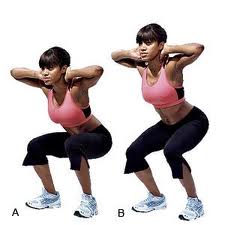Squatter’s Rights

Squats are often not performed right and when they are repeated incorrectly, they can cause knee and back problems and muscle imbalances. There are three basic squats ; the half squat, parallel squat and the Asian squat (or full squat) and there are many variations of the three. When executed properly, squats are one of the most effective exercises for the legs, butt, back and abs. Here is the best way to do a parallel squat:
Start with your feet a little more than shoulder width apart. Keeping your chest lifted and abs pulled in, bend at the hip first to lower the torso as if to sit down in a chair. Keep your knees outward over your feet as you lower to your squat. Your thighs should be parallel to the floor and your heels should remain down. As you return to a standing position, drive your heels into the floor and feel the contraction of the hamstrings and glutes. Once you have mastered the basic, you can experiment with different arm positions and add weights.
Avoid: bending at the knees first as there is a tendency for them to cave in between your feet. You are not kneeling, you are squatting. Try not to flex the torso or round your back as it will increase the forces on your lower back, risking disc herniation. Do: Start by sitting down on a chair and returning to a standing position. Repeat but stop short of actually sitting, hover a second, and then stand. Keep your eyes looking forward rather than down in order to keep your back straight.
If you have bio-mechanical issues with your knees or are recovering from an injury, start by performing half-squats. It is your right to exercise with modifications in order to slowly build strength. And if it hurts, don’t do it!